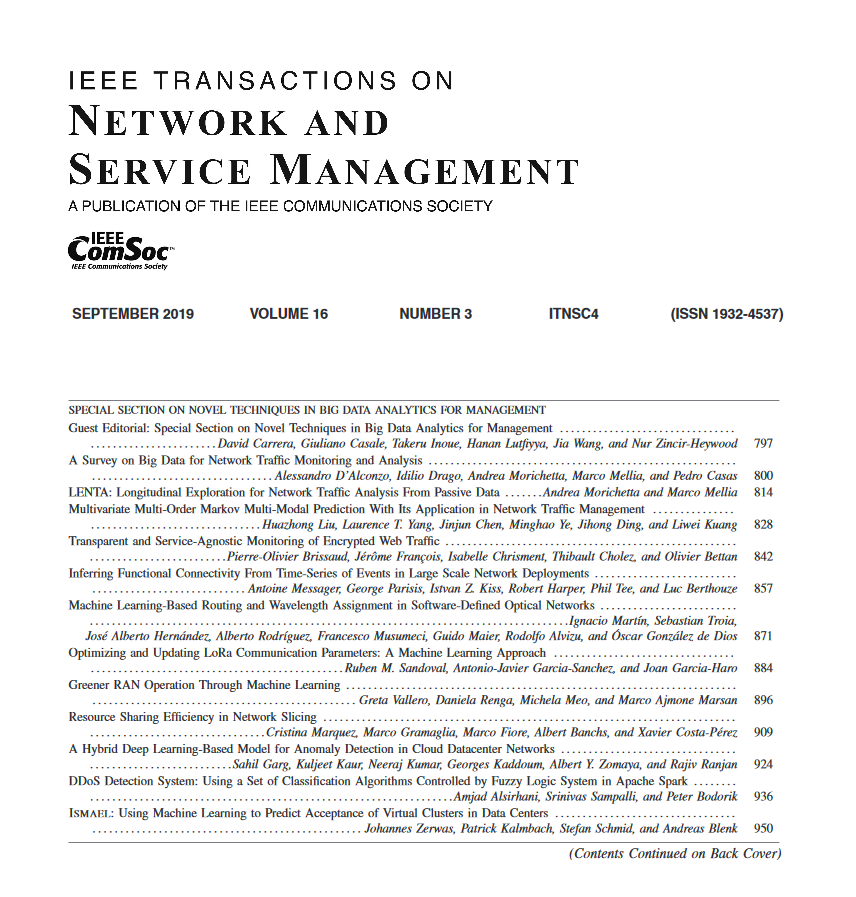A Novel E2E Path Selection Algorithm for Superior QoS and QoE for 6G Services
IF 5.4
2区 计算机科学
Q1 COMPUTER SCIENCE, INFORMATION SYSTEMS
IEEE Transactions on Network and Service Management
Pub Date : 2024-12-18
DOI:10.1109/TNSM.2024.3519707
引用次数: 0
Abstract
The progression of Sixth-Generation (6G) services requires networks to meet stringent Quality of Service (QoS) and Quality of Experience (QoE) standards, demanding superior performance from all network segments. Selecting the most suitable path that meets application demands across multiple network segments is a key strategy for achieving these objectives. Traditional and modern path selection methods focus on QoS metrics such as bandwidth and latency to ensure efficient and reliable data delivery. However, as 6G introduces more interactive applications like Virtual Reality (VR) and Augmented Reality (AR), prioritizing user experience alongside QoS metrics becomes more crucial. This paper presents a Service-Aware Optimal Path Selection (SOPS) algorithm designed to select an optimal End-to-End (E2E) path for each application by minimizing a global cost function that incorporates both QoS and QoE parameters. The global optimality of the selected E2E path is proven by demonstrating the closed and convex nature of the underlying cost functions. Moreover, our proposed distributed cost function ensures optimal E2E paths formed from selected network segment-specific paths. Extensive simulations show that SOPS improves QoS and QoE when compared with other state-of-the-art routing algorithms. SOPS enhances QoS by improving reliability by 0.84% and reducing packet delay by 5.55%. An improvement of up to 99.65% is seen in the connection acceptance ratio, particularly for diverse application requirements. Significant improvements in QoE are observed across Hypertext Transfer Protocol (HTTP) and video applications, with throughput increases of 10.04% and 7.99%, jitter reductions of 86.25% and 2.49%, and delay improvements of 77.08% and 0.69%, respectively.一种新的实现6G业务优质QoS和QoE的端到端路径选择算法
随着第六代(6G)业务的发展,网络需要满足严格的QoS (Quality of Service)和QoE (Quality of Experience)标准,要求所有网段都具有卓越的性能。选择最合适的路径来满足跨多个网段的应用程序需求是实现这些目标的关键策略。传统和现代的路径选择方法都关注带宽和延迟等QoS指标,以确保高效可靠的数据传输。然而,随着6G引入更多交互性应用,如虚拟现实(VR)和增强现实(AR),优先考虑用户体验和QoS指标变得更加重要。本文提出了一种服务感知最优路径选择(SOPS)算法,通过最小化包含QoS和QoE参数的全局成本函数,为每个应用程序选择最优的端到端(E2E)路径。所选择的端到端路径的全局最优性是通过证明底层成本函数的封闭和凸性来证明的。此外,我们提出的分布式成本函数确保了由选定的网段特定路径形成的最优端到端路径。大量的仿真表明,与其他最先进的路由算法相比,SOPS提高了QoS和QoE。SOPS提高了服务质量,可靠性提高了0.84%,数据包延迟降低了5.55%。连接接受率提高了99.65%,特别是在不同的应用要求下。在超文本传输协议(Hypertext Transfer Protocol, HTTP)和视频应用中,QoE得到了显著改善,吞吐量分别提高了10.04%和7.99%,抖动分别减少了86.25%和2.49%,延迟分别提高了77.08%和0.69%。
本文章由计算机程序翻译,如有差异,请以英文原文为准。
求助全文
约1分钟内获得全文
求助全文
来源期刊

IEEE Transactions on Network and Service Management
Computer Science-Computer Networks and Communications
CiteScore
9.30
自引率
15.10%
发文量
325
期刊介绍:
IEEE Transactions on Network and Service Management will publish (online only) peerreviewed archival quality papers that advance the state-of-the-art and practical applications of network and service management. Theoretical research contributions (presenting new concepts and techniques) and applied contributions (reporting on experiences and experiments with actual systems) will be encouraged. These transactions will focus on the key technical issues related to: Management Models, Architectures and Frameworks; Service Provisioning, Reliability and Quality Assurance; Management Functions; Enabling Technologies; Information and Communication Models; Policies; Applications and Case Studies; Emerging Technologies and Standards.
 求助内容:
求助内容: 应助结果提醒方式:
应助结果提醒方式:


